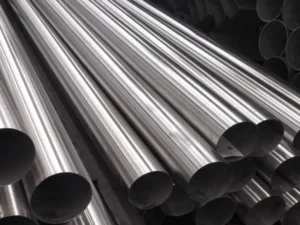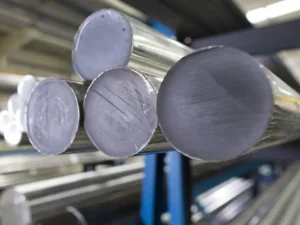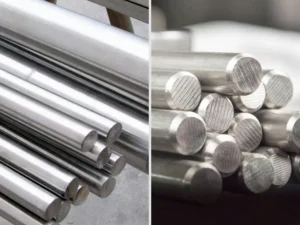Stainless steel is well known due to its corrosion resistance. All of its grades are equipped with excellent properties. Manufacturers use them to make durable products. However, the grades 304 vs 316 stainless steel are among the most discussed.
Both 304 and 316 austenitic stainless steel look similar in appearance, but they are different in many ways. To understand their distinction, one must look into their chemical compositions. In this piece, we will analyze the key differences between these two. So, let’s get started!
Overview of 304 and 316 Stainless Steel

These alloys differ in terms of their chemical composition. The alloy 304 contains 18% chromium and 8% nickel. On the other hand, 316 stainless steel comprises 16% chromium, 10% nickel, and 2% molybdenum. Due to molybdenum, 316 SS is considered superior.
Both of these alloys are strong and hard. They are used in products where corrosion resistance is required. Both consist of chromium, which forms a chromium oxide layer on the surface. This layer protects the product from getting corroded, making them famous.
Their usage is common in many industries. However, 316 is considered more suitable for the professional level. This is because 316 contains molybdenum, which offers better heat resistance. From the physical appearance, both of these two alloys look similar.
Different chemical tests are conducted to distinguish them. If you’re going to buy them from any shop, make sure to get a testing certificate. The chances of scams are high as both are similar. Some ill-intent sellers sell 304 in the name of 316. Remember, the 316 is premium and more expensive. Thus, you pay more to get 304 stainless steel.
What are the Differences between 304 and 316 Stainless Steel?

As I said earlier, numerous of their characteristics are similar. Many people consider them similar and use them interchangeably. However, there are some key differences. Understanding these two requires a deep analysis. Let’s drill down and discuss their prominent differences.
1- Chemical Composition
One of the most prominent differences between them is their chemical composition. 304, also known as 18/8 stainless steel, doesn’t contain molybdenum. On the other hand, 316 stainless steel has 2% of molybdenum. The presence of this element in 316 makes it more heat resistant and harder.
The chemical composition of 304 alloys is as follows:
- Chromium: 18.0%
- Nickel: 8.0%
- Carbon: ≤ 0.08%
- Manganese: ≤ 2.0%
- Silicon: ≤ 1.0%
- Phosphorus: ≤ 0.045%
- Sulfur: ≤ 0.030%
- Nitrogen: ≤ 0.10%
- Iron: Traces
Chromium and nickel are present in higher amounts. The other elements that are peasant in trace don’t have much impact on their properties. Chromium is a premium element that makes 304 corrosion-resistant. Let’s have a look at the chemical composition of 316 stainless steel:
- Chromium: 16%
- Nickel: 10%
- Molybdenum: 2%
- Carbon: 0.08% max
- Manganese: 2.0% max
- Silicon: 1.0% max
- Phosphorus: 0.045% max
- Sulfur & Iron: 0.03% max
- Nitrogen: 0.10% max
The 2% of molybdenum is noteworthy. This element makes 316 SS premium. It imparts strength, hardness, and corrosion resistance against salts and chlorides. Thus, 316 is considered superior to 304 SS.
2- Heat Resistance
Both 316 and 304 austenitic stainless steel offer decent heat resistance. Their withstanding power to high heat is also the same. To 870°C (1598°F), the 304 remains in good shape. However, if you heat it continuously at this temperature, it deteriorates. Their extended heating can lead to carbide precipitation and, ultimately, to corrosion.
However, 316 stainless steel is stronger and harder. You can continuously heat it to 925°C, and it won’t deteriorate. This withstanding power is due to 2% molybdenum. Therefore, 316 stainless steel is considered better in terms of heat resistance.
3- Corrosion Resistance
Both 304 and 316 contain chromium in varying amounts. When it comes into contact with moisture, this chromium material forms a chromium oxide layer. This additional protective layer saves the material from rusting and corrosion. This is common for both 316 and 304.
However, 304 also offers excellent corrosion resistance when it comes into contact with salt or chloride. This is due to the molybdenum present in 316 stainless steel. On the contrary, 304 does not have molybdenum. Thus, it does not offer ideal corrosion resistance.
Notably, 316 stainless steel resists acid, alkalis, and other elements. This is due to its better chemical composition. A product made with this material does not. This is due to it remaining in contact with acid for an extended duration.
Quick Tip: 316 stainless steel is used to make marine contacts. These products remain in seawater and don’t get corroded. 304 is not good for those products. Instead, it is only good for corrosion caused by moisture.
4- Weldability & Formability
Both of these two alloys can be welded. However, 304 stainless steel offers better weldability and formability. The reason is that it is not as rigid as 316. So, when heat is provided, it does not break or get brittle. Thus, the fabricators can easily weld by TIG or MIG and use the 304.
As I said, 316 contains molybdenum, which enhances its hardness. Thus, this stainless steel becomes unstable and brittle when heat is provided during welding. Therefore, it is considered sensitive to welding. 304 stainless is suitable for welding, formability, and fabrication.
5- Mechanical Properties
The 316 stainless steel is considered better in terms of mechanical properties. Although 304 is also good, when compared to 316, it lags. Those properties are as follows:
- Tensile strength
- Yield strength
- Elongation at break
The 316 SS has a higher ultimate tensile strength of 79800 psi compared to 304 stainless steel’s 73200. Similarly, the yield strength of 316 is 34800, whereas its counterpart is 31200. The stats show that 316 has better properties and is more stable than its counterpart.
Let’s discuss the elongation at break. 304 stainless steel is good at elongation. It can be stretched up to 70% of the original size and does not break. Conversely, 316 offers 60% elongation and slightly trails 304.
Applications of 304 and 316 Stainless Steel
Both of these alloys are actively used in different industries. Due to their corrosion resistance, these are the go-to options for manufacturers. However, they differ in terms of their application and usability. Typical 304 is used to make kitchen-related products.
On the other hand, 316 is famous in the marine industry. Manufacturers use it to make marine products that remain in salty water. This is because it resists corrosion well in salty environments and against chlorides. Due to its high-temperature resistance, it is also used in the medicine industry.
Here is their detailed application comparison:
| Applications of 304 | Applications of 316 |
| Household Appliances | Marine products, boat fittings, hardware, etc |
| Food processing equipment | Medical devices and surgical instruments |
| Architectural applications like facades | Stainless steel baskets |
| Electrical components | Automobile parts |
| Water pipes and auto moldings | Applications in HVAC systems |
It is important to note these two alloys are extensively used across industries. From automobiles to home appliances, manufacturers are making full use of them. However, 316 stainless steel is the most used due to its corrosion resistance in salty environments.
Quick Note: Read our other detailed guide if you are interested in learning about different grades of steel. Those types include alloy steel, stainless steel, and many more.
Is 316 More Expensive than 304?
Yes, 316 stainless steel is premium and more expensive. But it is worth the higher price because of its top-notch quality. 316 SS offers better durability, corrosion resistance, and high-temperature resistance. It proves to be a better investment in the long run.
304 is inexpensive and offers compromised qualities. For example, products made with 304 will rust when they come into contact with salty water, but that is not the case when you use 316 stainless steel. The durability of the material is paramount in the manufacturing process.
The manufacturer achieves ideal durability using 316 stainless steel, which is more popular than 304 despite its higher prices. Whether you should opt for 304 or 316 will depend on your preferences. Choosing 316 will give you peace of mind in the long run.
What’s Better, 304 or 316 stainless Steel?

316 stainless steel offers better durability and resistance to corrosion. Even products made with this material can withstand a salty environment. 304 stainless steel gets rusty if it remains outside under salty conditions.
Apart from corrosion resistance, 316 also withstands high temperatures. If you’re making a part that will undergo heat, 316 will behave better. When it comes to hardness, both these alloys are quite similar. Keep in mind that 2% of molybdenum makes 316 premium.
However, personal experiences can vary. What makes 304 popular is its cost-effectiveness. If you’re on a tight budget, then 304 would be a suitable option for you. You’ll be able to get your product done at affordable pricing.
Need to decide between stainless 304 vs. 316 and are still confused? Fret not. Let me make this decision more straightforward:
Choose 304 when you have a compromised budget. This will be a good starting point. Although it won’t give you ideal durability, you’ll get the product running. However, opt for 316 stainless steel without thinking twice if you want perfect durability.
Frequently Asked Questions
Can f and 316 stainless steel be recycled?
Yes, both 304 and 316 stainless steel are highly recyclable materials. They don’t lose their inherent properties after recycling, which is one of the reasons industries actively use stainless steel alloys.
Can both grades be used in contact with chemicals?
Both 304 and 316 are resistant to chemicals. However, 316 is more suitable for chemical contact. This material is resistant to corrosion from acids, alkalis, and chloride solutions, so exposure to the harshest chemicals and conditions won’t affect it.
Do 304 and 316 have different levels of conductivity for heat and electricity?
Yes, there are differences in thermal and electrical conductivity. 316 stainless steel has slightly lower thermal and electrical conductivity
Why choose stainless steel 304?
This material remains unaffected even when exposed to acids and alkalis. Therefore, utilizing it and capitalizing on its exceptional properties is wise.
Conclusion
Now, ask yourself: Which one should you consider for your project? I’m sure that you’ll be able to answer your query. Both 304 and 316 are excellent and serve their purposes. 304 is recommended for beginners as it is inexpensive.
However, 316 would be suitable for professionals due to its premium qualities. Although it is expensive, its characteristics are worth every penny.
